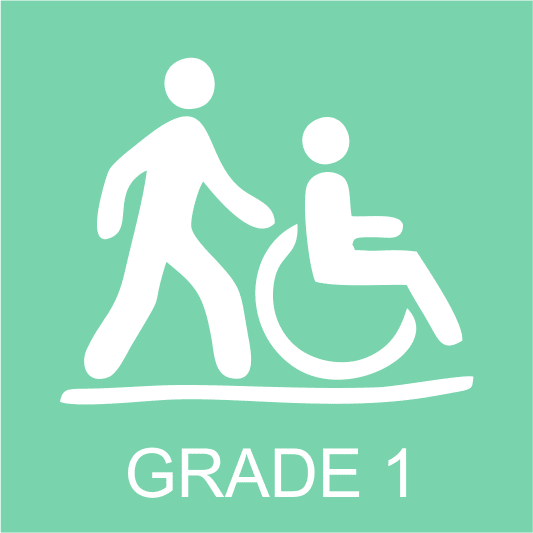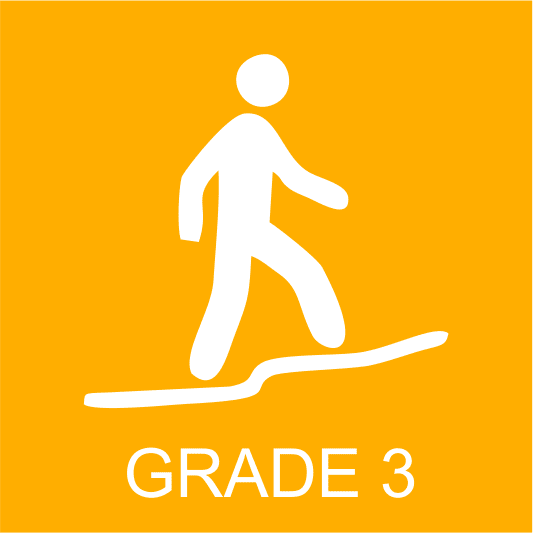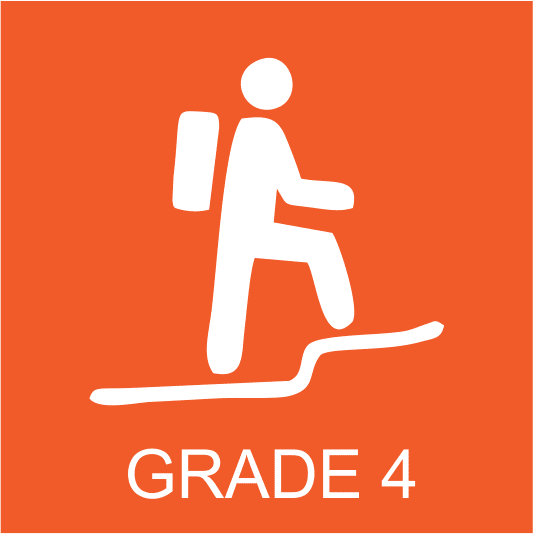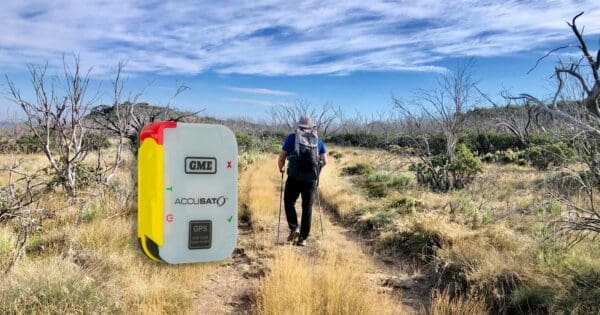The walking track grading system in Australia
The Australian Walking Track Grading System (AWTGS), endorsed by the Council of Bushwalking Australia in March 2011, aims to provide a clear, nationally consistent method for grading the difficulty of walking tracks. This system helps walkers understand what to expect on different trails.
How the AWTGS Works
The system grades walking experiences on a scale from one to five:

Grade 1 (All-abilities)
Suitable for people with a disability or wheelchair with assistance. No hiking experience required as trails have a flat even surface with no steps or steep sections. Hikes generally less than 5km.

Grade 2 (Easy)
Suitable for families with young children. No hiking experience required as trails have a harder compacted surface. Expect gentle hills and occasional steps. Hikes generally less than 10km.

Grade 3 (Moderate)
Suitable for most ages and fitness levels. Hiking experience is recommended as trails may have short steep hill sections, rough surfaces and natural steps. Hikes generally less than 20km.

Grade 4 (Hard)
Suitable for experienced hikers as navigation and technical skills will be required. Trails will be long, rough and very steep with limited signage or navigation aids. Rock scrambling and river crossings may be required. Hikes generally less than 25km.

Grade 5 (Difficult)
Suitable for highly experienced self-reliant hikers with specialised skills, including map and compass navigation and emergency first aid. Trails will be unmarked, long, very rough and very steep. Rock scrambling and river crossings may be required. Hikes generally greater than 25km.
Why Use the AWTGS?
The Australian Walking Track Grading System (AWTGS) is a valuable tool for planning safe and enjoyable hikes. By understanding the grading system, you can choose trails that align with your fitness level and experience, reducing the risk of injuries, getting lost, or needing rescue. Additionally, the AWTGS helps set realistic expectations about a trail’s difficulty, so you can pick a hike that’s challenging but achievable, leading to a more fun and rewarding experience. Whether you’re looking for a leisurely family outing on a Grade 2 trail or a challenging trek with breathtaking views on a Grade 4 or 5 trail, remember, difficulty can be subjective. Consider your own abilities and comfort level when choosing a trail to ensure a safe and enjoyable adventure.
Understanding the AWTGS Limitations
The Australian Walking Track Grading System (AWTGS) is a valuable tool for planning hikes, but it’s important to understand its limitations to ensure a safe and enjoyable experience. While the AWTGS considers factors like distance, time, and gradient, it doesn’t account for everything that can impact a hike’s difficulty. Here’s why it’s essential to look beyond the grade.
From years of hiking in the Australian bush, I’ve found that the AWTGS may not adequately prepare hikers and can sometimes mislead people into undertaking hikes they are not prepared for. Public descriptions can misrepresent the experience and expertise required.
For instance, the AWTGS suggests that ‘bushwalking experience is recommended’ for a Grade Four walk. However, I argue that bushwalking experience is essential for this grade. The description lacks details on necessary navigation or technical skills, despite mentioning that ‘directional signage may be limited’. This ambiguity can mislead hikers, potentially putting them in danger.
The AWTGS is a valuable guide for planning hikes, but it’s just a starting point. To maximise your safety and enjoyment on the trails, consider the following:
- Understand the Limitations: The AWTGS provides a general difficulty rating but doesn’t account for unforeseen challenges like river crossings, loose rocks, or environmental factors such as weather and seasonal variations. Supplement the AWTGS with thorough research on your chosen trail, considering current conditions, weather forecasts, and any unique features like challenging navigation sections.
- Match the Trail to Your Abilities: Honestly assess your fitness level and experience before hitting the track. The AWTGS might categorise a trail as easy based on distance, but that doesn’t mean it’s suitable for everyone. Choose a trail that aligns with your capabilities to avoid overexertion and ensure a more enjoyable adventure.
Limitations Based on Distance
The AWTGS uses distance as a classification factor. Grade 1 trails are under 5km, Grade 2 under 10km, and Grade 3 under 20km. While this offers a general guideline, it can be misleading, particularly for hikes graded 1 through 3. Here, distance often reflects the fitness level required to complete the entire trail comfortably rather than the technical difficulty of the terrain itself.
For instance, a flat, well-maintained rail trail suitable for all-abilities access might be 23km long, putting it in Grade 4 solely due to distance. This doesn’t reflect the ease of the trail itself. Someone could comfortably traverse a few kilometers of this trail and return, enjoying a scenic and achievable walk. However, the Grade 4 classification might discourage them entirely.
Conversely, completing this long, flat, well-maintained Grade 4 rail trail might lead someone to believe they are prepared for a challenging Grade 4 hike in rugged mountainous terrain. Here, the AWTGS doesn’t account for the difference in difficulty brought on by factors like uneven surfaces, navigation complexity, and the need for bushwalking experience.
Grades are a great guide, but you have to look beyond them to truly understand the challenges and assess the difficulty yourself. Remember, the AWTGS is just a starting point.
The AWTGS: A look beyond the numbers
While helpful, the AWTGS has its critics. Some users find the single-grade system overly simplistic, especially for overnight hikes. For instance, an AWTGS Grade 4 track designated for an overnight stay with a full pack might be much easier than expected, while another Grade 4 track could be far more challenging due to factors like steep climbs or unpredictable weather.
The grading system can provide a false sense of security or exclude people from discovering certain tracks. The technical rating of a trail can be influenced by various conditions such as terrain, topography, elevation gain, signage, length, duration, season, environment, and experience. There are no hard and fast rules for why a trail receives a particular grade, and conditions may vary. For example:
- A long, gradual uphill section on a well-maintained track might be classified as Grade 3 by AWTGS, but it could be quite challenging for someone new to hiking, especially on a hot day.
- A 25km hike that is relatively easy might be considered by the walker as Grade 3 but classified by the AWTGS as Grade 4 purely due to its length.
- Sections of the Grampians Peaks Trail (Victoria) are classified Grade 5, but pale in comparison to the Grade 5 Western Arthur Traverse in Tasmania.
- A popular trail in an alpine environment might be classified as Grade 3 but can quickly turn into a Grade 5 adventure in the heart of winter with snowfall.
Beyond the Grading System: Personal preparation is key
While the Australian Walking Track Grading System (AWTGS) considers factors like distance, time, gradient, path quality, markings, and experience required, it doesn’t account for everything that can impact a hike’s difficulty. Here’s why it’s important to look beyond the grade:
- Unforeseen challenges: The AWTGS might not capture specific obstacles like river crossings, rock scrambles, or exposure that can significantly increase difficulty.
- Environmental factors: The system doesn’t consider how weather or seasonal changes can drastically alter the terrain (e.g., loose rocks after rain, snow cover).
- Personal experience: Your experience level in similar terrain can be more important than the AWTGS’s generic “experience required” category.
The AWTGS is a starting point, but successful and safe hiking requires personal preparation. Before heading out, research the specific trail, consider your fitness level and experience, and factor in potential seasonal variations. By planning thoroughly, you’ll ensure a safe and enjoyable adventure. Here’s some additional factors to consider:
- Individual Fitness and Experience: Assess your own fitness level and experience before hitting the trail. Choose a track that matches your capabilities to avoid overexertion or difficulty.
- Seasonal Variations and Weather Conditions: Research the specific trail conditions for the time of year you plan to hike. Weather and seasonal changes can significantly alter the difficulty. A well-maintained Grade 3 track in summer might become a challenging Grade 5 hike after heavy rain or snowfall.
How have I graded trails on this website?
Using the Australian Walking Track Grading System
The application of the Australian Walking Track Grading System is a two step process.
- The first step is a technical grading of the walk. The land manager determines a walk’s grade of difficulty using descriptors taken from the Australian Standard 2156.1 – 2001 Walking Tracks – Classification and Signage.
- The second step is to communicate to the public why a walk has received its grading – in essence translating the technical grading into ‘plain English language’.
- Check out the AWTGS Users Guide if you want to learn more.
The AWTGS: A Stepping Stone to Safe Hiking
The Australian Walking Track Grading System (AWTGS) is a valuable tool for planning hikes, but it’s important to remember it’s just a starting point. To truly maximise your safety and enjoyment on the trails, there are some key takeaways to keep in mind.
Firstly, understand the limitations of the AWTGS. While it provides a general difficulty rating, it doesn’t account for everything that can impact your experience. Unforeseen challenges like river crossings or loose rocks, along with environmental factors like weather and seasonal variations, can significantly alter the difficulty of a trail. To supplement the AWTGS, conduct thorough research on your chosen trail, considering current conditions, weather forecasts, and any unique features like challenging navigation sections.
Secondly, ensure the trail you choose matches your abilities. Honestly assess your fitness level and experience before hitting the track. The AWTGS might categorise a trail as easy based on distance, but that doesn’t mean it’s suitable for everyone. By choosing a trail that aligns with your capabilities, you can avoid overexertion and ensure a more enjoyable adventure.
Hiking with Responsibility: Protecting the Trails We Love
With the AWTGS as a guide and your own preparation in place, you’re ready to explore the wonders of Australian hiking trails! But remember, hiking is about enjoying nature responsibly. Here’s how you can be a part of a sustainable hiking community:
- Tread Lightly: Always stay on designated tracks. This minimises your impact on the delicate ecosystems these trails traverse.
- Leave No Trace: Pack out all your rubbish, and avoid disturbing wildlife or vegetation. By following Leave No Trace principles, you ensure the beauty of these trails is preserved for future generations.
- Respect the Trails: Always follow trail rules and signage. This not only ensures your safety but also the safety of other hikers.
By following these simple principles, you can contribute to a safe, enjoyable, and sustainable hiking experience in Australia. Remember, responsible hiking practices are key to protecting these beautiful trails for ourselves and future adventurers.






I think a distinction needs to be made for technical difficulty versus simple length. I have kids and when looking for hikes to go on with them, I have to be very careful in my assessment, looking at the description more than the number.
Matthew White the grading is based on quite a range of factors which includes length, difficulty, terrain, topography, availability of trail markers etc. Agree they should only be used as a guide and more in depth analysis is needed to find the right trail.
Club grade systems are much better.